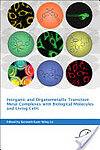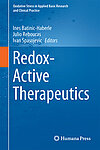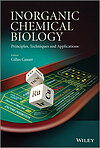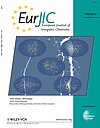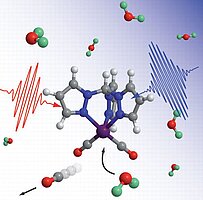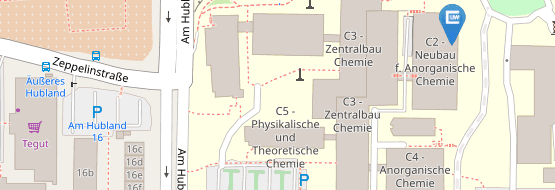CO-releasing Molecules
CO-releasing molecules (CORMs)
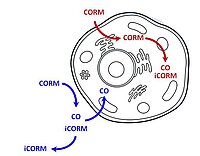
Biological activity of carbon monoxide
To the general public, carbon monoxide is usually only known as a highly toxic air pollutant resulting from the incomplete combustion of carbon materials. However, it is in fact also enzymatically generated in higher organisms, including humans, by the activity of heme oxygenase (HO) on heme. Over the last decade or so, a wide range of biological processes were demonstrated to be influenced by such endogenously produced carbon monoxide and researchers have now also started to explore its therapeutic potential in human medicine.

Carbon monoxide delivery systems
Since carbon monoxide gas is difficult to dose and distributes in the body solely based on the partition ratio between different body fluids and tissues, researchers have started to explore organic and metal carbonyl compounds as carbon monoxide delivery systems, commonly referred to as CO-releasing molecules (CORMs).
For almost a decade, the Schatzschneider group has been involved in the development of metal-carbonyl complexes as CO-releasing molecules, with a particular focus on the use of light to initiate the release of carbon monoxide from the carrier molecule, which enables spatial and temporal control of the release process. Such photoactivatable CO-releasing molecules (PhotoCORMs) are now explored for their biological potential in the context of wound healing and antibacterial chemotherapy.
In addition to optimization of the CO release parameters, such as excitation wavelength and release kinetics, which are controlled by proper metal-coligand combinations (called the CORM sphere), the focus of our research has now increasingly shifted towards the improvement of the bioavailability of our CO-releasing molecules, which involves systematic variation of the outer ligand periphery (called the drug sphere).
A relatively new approach we have started to explore only recently is the encapsulation of CO and CORMs in solid nanomaterials for slow release and retention of metal-coligand byproducts of the release process.
Reviews
For some general reviews from the Schatzschneider group on the biological activity of CO as well as NO and H2S as the other two small signaling molecules, and the use of metal complexes as delivery systems for carbon monoxide, see for example:
- U. Schatzschneider, Metal complexes as delivery systems for CO, NO, and H2S to explore the signaling network of small-molecule messengers, in: K.K.-W. Lo (ed.) Interactions of inorganic and organometallic transition metal complexes with biological molecules and living cells, Academic Press, Cambridge, 2017
- P.V. Simpson, U. Schatzschneider, Small signaling molecules and CO-releasing molecules (CORMs) for the modulation of the cellular redox metabolism, in: I. Batinic-Haberle, J.S. Reboucas, I. Spasojevic (eds.) Redox-active therapeutics, Springer, Cham, 2016
- P.V. Simpson, U. Schatzschneider, Release of bioactive molecules using metal complexes, in: G. Gasser (ed.) Inorganic Chemical Biology: Principles, Techniques and Applications, Wiley, Chichester, 2014
- U. Schatzschneider, Novel lead structures and activation mechanisms for CO-releasing molecules (CORMs), Brit. J. Pharmacol. 172, 1638-1650 (2015)
- U. Schatzschneider, PhotoCORMs: Light-triggered release of carbon monoxide from the coordination sphere of transition metal complexes for biological applications, Inorg. Chim. Acta 374, 19-23 (2011)
- U. Schatzschneider, Photoactivated biological activity of transition-metal complexes, Eur. J. Inorg. Chem. 1451-1467 (2010)
Biological activity of CORMs
In a number of studies, the Schatzschneider group has investigated the antitumor and antibacterial activity of CO-releasing molecules (CORMs). A particularly useful tool to study the CO release in living human cells is the use of the COP-1 fluorescent probe developed by the laboratory of Prof. Dr. Chris Chang at the University of California at Berkeley (UCB):
- A. Liakopoulos, R.M. La Ragione, C. Nagel, U. Schatzschneider, D. Rozen, J.W. Betts, Manganese complex [Mn(CO)3(tpa-κ3N)]Br restores antibiotic sensitivity to multidrug resistant Streptococcus pneumoniae, J. Glob. Antimicrob. Resist. 22, 594-597 (2020)
- P. Güntzel, C. Nagel, J. Weigelt, J.W. Betts, C.A. Pattrick, H.M. Southam, R.M. La Ragione, R.K. Poole, U. Schatzschneider*, Biological activity of manganese(I) tricarbonyl complexes on multidrugresistant Gram-negative bacteria: From functional studies to in vivo activity in Galleria mellonella, Metallomics 11, 2033-2042 (2019)
- J. Betts, C. Nagel, U. Schatzschneider, R. Poole, R.M. la Ragione, Antimicrobial activity of carbon monoxide-releasing molecule [Mn(CO)3(tpa-κ3N)]Br versus multidrug-resistant isolates of Avian Pathogenic Escherichia coli and its synergy with colistin, PLOS ONE 12, e0186359 (2017)
- N. Rana, H. Jesse, M. Tinajero-Trejo, J. Butler, M.L. von und zur Mühlen, C. Nagel, U. Schatzschneider, R.K. Poole, A manganese photosensitive tricarbonyl molecules [Mn(CO)3(tpa-k3N)]Br enhances antibiotic efficacy in a multi-drug-resistent Escherichia coli, Microbiology 163, 1477-1489 (2017)
- M. Tinajero-Trejo, N. Rana, T.W. Smith, C. Nagel, M.F. Hippler, U. Schatzschneider, R.K. Poole, Antimicrobial activity of the manganese photo-activated CO-releasing molecule [Mn(CO)3(tpa-κ3N)]+ against a multidrug-resistant Eschericha coli, Antioxid. Redox Signal. 24, 765-780 (2016)
- C. Nagel, S. McLean, R.K. Poole, H. Braunschweig, T. Kramer, U. Schatzschneider, Introducing [Mn(CO)3(tpa-k3N)]+ as a novel photoactivatable CO-releasing molecule with well-defined iCORM intermediates - Synthesis, spectroscopy, and antibacterial activity, Dalton Trans. 43, 9986-9997 (2014)
- S. Pai, M. Hafftlang, G. Atongo, C. Nagel, J. Niesel, S. Botov, H.-G. Schmalz, B. Yard, U. Schatzschneider, New modular manganese(I) tricarbonyl complexes as PhotoCORMs: In vitro detection of photoinduced carbon monoxide release using COP-1 as a fluorogenic switch-on probe, Dalton Trans. 43, 8664-8678 (2014)
- J. Niesel, A. Pinto, H.W. Peindy N'Dongo, K. Merz, I. Ott, R. Gust, U. Schatzschneider, Photoinduced CO release, cellular uptake and cytotoxicity of a tris(pyrazolyl)methane manganese tricarbonyl complex, Chem. Commun. 1798-1800 (2008)
Advanced spetroscopy on CORMs
A wide range of advanced spectroscopic methods was utilized to investigate the primary photophysical and photochemical processes on light-triggered CO release and localization of CORMs in biological systems based on their inherent spectroscopic signature. For example, in cooperation with the group of Prof. Dr. Patrick Nürnberger at the Ruhr-Universität Bochum (RUB), UV/Vis pump-IR probe spectroscopy on the femtosecond timescale was used to study the initial excited states of a PhotoCORM when triggered at 264 nm. Together with Prof. Dr. Martina Havenith-Newen, also at RUB, Raman microspectroscopy allowed us to image the intracellular distribution of a CORM in livinig human cells.
- P. Roth, L. Suntrup, B. Sarkar, U. Schatzschneider, IR spectroelectrochemistry of a heterobimetellic ferrocene-CORM conjugate, J. Organomet. Chem. 975, 122383 (2022)
- N. Gessner, A.K. Bäck, J. Knorr, C. Nagel, P. Marquetand, U. Schatzschneider, L. Gonzalez, P. Nürnberger, Ultrafast photochemistry of a molybdenum carbonyl-nitrosyl complex with a triazacyclononane coligand, Phys. Chem. Chem. Phys. 23, 24187-24199 (2021)
- P. Rudolf, F. Kanal, J. Knorr, C. Nagel, J. Niesel, T. Brixner, U. Schatzschneider, P. Nürnberger, Ultrafast photochemistry of a manganese-tricarbonyl CO-releasing molecule (CORM) in aqueous solution, J. Phys. Chem. Lett. 4, 596-602 (2013)
- K. Meister, J. Niesel, U. Schatzschneider, D. Schmidt, N. Metzler-Nolte, M. Havenith-Newen, Metal-carbonyl complexes as a new modality for label-free live cell imaging by Raman microspectroscopy, Angew. Chem. Int. Ed. 49, 3310-3312 (2010)
CO- and NO-releasing molecules
A wide range of metal-carbonyl and nitrosyl complexes has been investigated as CO- and NO-releasing molecules. The focus of our work has been on manganese(I) tricarbonyl complexes of the general formula fac-[MnBr(CO)3(N^N)] and fac-[Mn(CO)3(N^N^N)]+ with bi- and tridentate chelating coligands. However, other metal carbonyl moieties, such as Ir(CO)2, Ru(CO)2, and Fe(CO)3 was also investigated with a number of collaboration partners:
- A. Mansour, C. Steiger, C. Nagel, U. Schatzschneider, Wavelength-dependent control of the CO release kinetics of manganese(I) tricarbonyl PhotoCORMs with benzimidazole coligands, Eur. J. Inorg. Chem. 4572-4581 (2019)
- F. Wittkamp, C. Nagel, P. Lauterjung, B. Mallick, U. Schatzschneider, U.-P. Apfel, Phosphine-ligated dinitrosyl iron complexes for redox-controlled NO release, Dalton Trans. 45, 10271-10279 (2016)
- F. Strinitz, P. Trautner, H. Pfeiffer, U. Schatzschneider, N. Burzlaff, Synthesis and characterization of heteroscorpionate based manganese carbonyl complexes as CO releasing molecules, Tetrahedron 71, 2951-2954 (2015)
- P.V. Simpson, K. Radacki, H. Braunschweig, U. Schatzschneider, An iridium N-heterocyclic carbene complex [IrCl(CO)2(NHC)] as a carbon monoxide-releasing molecule (CORM), J. Organomet. Chem. 782, 116-123 (2015)
- C. Bischof, T. Joshi, A. Dimri, L. Spiccia, U. Schatzschneider, Synthesis, spectroscopic properties, and photoinduced CO release studies of functionalized ruthenium(II) polypyridyl complexes - versatile building blocks for the development of CORM-peptide nucleic acid bioconjugates, Inorg. Chem. 52, 9297-9308 (2013)
- P. Govender, S. Pai, U. Schatzschneider, G. Smith, Next generation PhotoCORMs: Polynuclear tricarbonylmanganese(I)-functionalised polypyridyl metallodendrimers, Inorg. Chem. 52, 5470-5478 (2013)
- W. Huber, R. Linder, J. Niesel, U. Schatzschneider, B. Spingler, P.C. Kunz, Comparative study of tricarbonyl manganese photoactivatable CO releasing molecules (PhotoCORMs) by using the myoglobin assay and time-resolved IR spectroscopy, Eur. J. Inorg. Chem. 3140-3146 (2012)
- F. Mohr, J. Niesel, U. Schatzschneider, C.W. Lehmann, Synthesis, structures, and CO releasing properties of two tricarbonyl manganese(I) complexes, Z. Anorg. Allgem. Chem. 638, 543-546 (2012)
- S. Romanski, B. Kraus, U. Schatzschneider, J.-M. Neudörfl, S. Amslinger, H.-G. Schmalz, Acyloxy-butadiene-Fe(CO)3 Complexes as Enzyme-Triggered CO-Releasing Molecules (ET-CORMs), Angew. Chem. Int. Ed. 50, 2392-2396 (2011)
- P.C. Kunz, W. Huber, A. Rojas, U. Schatzschneider, B. Spingler, Manganese and rhenium tricarbonyl complexes of imidazol-based phosphane ligands: Influence of the substitution pattern on the CO release properties, Eur. J. Inorg. Chem. 5358-5366 (2009)
CORM bioconjugates
The target affinity of CO-releasing molecules can be modulated by attachment to bio(macro)molecules. Over the last couple of years, the Schatzschneider group has utilized different bioorthogonal Click reactions such as Sonogashira, CuAAC, and oxime ligation reactions to attach manganese(I) tricarbonyl and molybdenum(0) tetracarbonyl moieties to a range of carrier peptides:
- S. Pai, K. Radacki, U. Schatzschneider, Sonogashira, CuAAC, and oxime ligations for the synthesis of Mn(I) tricarbonyl PhotoCORM peptide conjugates, Eur. J. Inorg. Chem. 2886-2895 (2014)
- H. Pfeiffer, T. Sowik, U. Schatzschneider, Bioorthogonal oxime ligation of a Mo(CO)4(N-N) CO releasing molecule (CORM) to a TGF beta-binding peptide, J. Organomet. Chem. 734, 17-24 (2013)
- H. Pfeiffer, A. Rojas, J. Niesel, U. Schatzschneider, Sonogashira and "Click" reactions in the N-terminal and side chain functionalization of peptides with [Mn(CO)3(tpm)]+-based CO releasing molecules (tpm = tris(pyrazolyl)methane), Dalton Trans. 4292-4298 (2009)
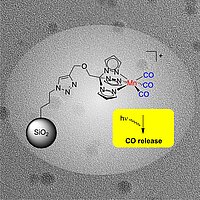
CORM nanomaterials
Surface modification of organic and inorganic hard nanomaterials such as nanodiamond or silica particles with CO releasing-molecules (CORMs) allows precise spatial and temporal control of the release process, while potentially cytotoxic byproducts remain bound to the surface. Alternatively, a porous nanomaterial can be directly loaded with CO gas coordinating to the metal building blocks, for example in metal-organic frameworks (MOFs):
- M. Ma, H. Noei, B. Mienert, J. Niesel, E. Bill, M. Muhler, R.A. Fischer, Y. Wang, U. Schatzschneider, N. Metzler-Nolte, Iron metal-organic frameworks MIL-88B and NH2-MIL-88B for the loading and delivery of the gasotransmitter carbon monoxide, Chem. Eur. J. 19, 6785-6790 (2013)
- G. Dördelmann, T. Meinhardt, T. Sowik, A. Krüger, U. Schatzschneider, CuAAC click functionalization of azide-modified nanodiamond with a photoactivatable CO releasing molecule (PhotoCORM) based on [Mn(CO)3(tpm)]+, Chem. Commun. 48, 11528-11530 (2012)
- G. Dördelmann, H. Pfeiffer, A. Birkner, U. Schatzschneider, Silicium dioxide nanoparticles as carriers for photoactivatable CO releasing molecules (PhotoCORMs), Inorg. Chem. 50, 4362-4367 (2011)


